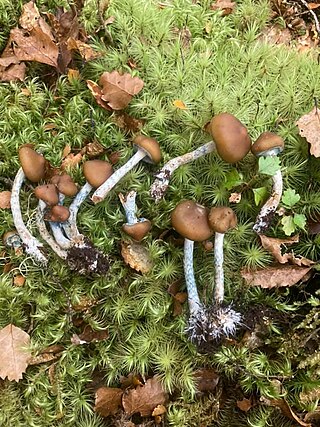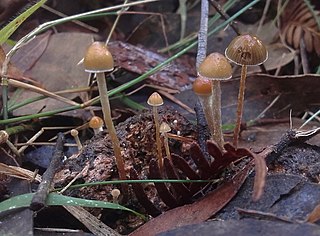
Psilocybe semilanceata, commonly known as the liberty cap, is a species of fungus which produces the psychoactive compounds psilocybin, psilocin and baeocystin. It is both one of the most widely distributed psilocybin mushrooms in nature, and one of the most potent. The mushrooms have a distinctive conical to bell-shaped cap, up to 2.5 cm (1 in) in diameter, with a small nipple-like protrusion on the top. They are yellow to brown, covered with radial grooves when moist, and fade to a lighter color as they mature. Their stipes tend to be slender and long, and the same color or slightly lighter than the cap. The gill attachment to the stipe is adnexed, and they are initially cream-colored before tinting purple to black as the spores mature. The spores are dark purplish-brown en masse, ellipsoid in shape, and measure 10.5–15 by 6.5–8.5 micrometres.

Psilocybe tampanensis is a very rare psychedelic mushroom in the family Hymenogastraceae. Originally collected in the wild in a sandy meadow near Tampa, Florida, in 1977, the fungus would not be found in Florida again until 44 years later. The original Florida specimen was cloned, and descendants remain in wide circulation. The fruit bodies (mushrooms) produced by the fungus are yellowish-brown in color with convex to conic caps up to 2.4 cm (0.9 in) in diameter atop a thin stem up to 6 cm (2.4 in) long. Psilocybe tampanensis forms psychoactive truffle-like sclerotia that are known and sold under the nickname "philosopher's stones". The fruit bodies and sclerotia are consumed by some for recreational or entheogenic purposes. In nature, sclerotia are produced by the fungus as a rare form of protection from wildfires and other natural disasters.

Psilocybe subaeruginosa is a species of agaric fungus in the family Hymenogastraceae described in 1927 and known from Australia and New Zealand. As a blueing member of the genus Psilocybe it contains the psychoactive compounds psilocin and psilocybin.
Psilocybe subaeruginascens is a psychedelic mushroom which has psilocybin and psilocin as main active compounds. This mushroom is closely related to Psilocybe ovoideocystidiata.

Psilocybe strictipes is a mushroom that grows on grassy meadows and lawns; It is found throughout the cool temperate and subarctic regions of the Northern Hemisphere and it is most common in Europe, and the Pacific Northwest region of North America. It contains the psychoactive compound psilocybin is closely related to Psilocybe semilanceata and Psilocybe pelliculosa. Psilocybe strictipes is commonly confused with Psilocybe semilanceata and can be differentiated by its lack of a papilla and a convex to subumbonate cap. "Strictipes" comes from the Latin words stricti (narrow) and pes (foot).
Psilocybe plutonia is a small psilocybin mushroom of the family Hymenogastraceae, believed to contain psilocybin and psilocin. It was first documented from Cuba. An older synonym is Agaricus plutonia.
Psilocybe naematoliformis, is a species of fungus in the mushroom family Hymenogastraceae. It is a psilocybin mushroom, having psilocybin and psilocin as the main active hallucinogenic compounds.

Macrolepiota clelandii, commonly known as the slender parasol or graceful parasol, is a species of mushroom-forming fungus in the family Agaricaceae. The species is found in Australia and New Zealand, where it fruits singly or in small groups on the ground in eucalypt woodlands, parks, and roadsides. It is a tall mushroom up to roughly 20 cm (8 in), with a broad cap covered with distinctive rings of dark brown scales. The whitish gills on the cap underside are closely spaced and free from attachment to the slender stipe, which has a loose ring on its upper half, and a bulbous base. The edibility of the mushroom is not known with certainty, but closely related parasol mushrooms are edible and some are very sought after.

Psilocybe aztecorum is a species of psilocybin mushroom in the family Hymenogastraceae. Known from Arizona, Colorado, central Mexico, India and Costa Rica, the fungus grows on decomposing woody debris and is found in mountainous areas at elevations of 2,000 to 4,000 m, typically in meadows or open, grassy conifer forests. The mushrooms have convex to bell-shaped caps 1.5–2 cm (0.6–0.8 in) in diameter, atop slender cylindrical stems that are up to 7.5 cm (3.0 in) long. The color of the caps changes with variations in hydration, ranging from dark chestnut brown to straw yellow or whitish when dry. The base of the stem is densely covered with conspicuous white rhizomorphs, a characteristic uncommon amongst Psilocybe species.

Psilocybe hoogshagenii is a species of psilocybin mushroom in the family Hymenogastraceae. The mushroom has a brownish conical or bell-shaped cap up to 3 cm (1.2 in) wide that has an extended papilla up to 4 mm long. The stem is slender and 5 to 9 cm long. The variety P. hoogshagenii var. convexa lacks the long papilla.

Psilocybe makarorae is a species of psilocybin mushroom in the family Hymenogastraceae. Officially described as new to science in 1995, it is known only from New Zealand, where it grows on rotting wood and twigs of southern beeches. The fruit body (mushroom) has a brownish cap with lighter coloured margins, measuring up to 3.5 cm (1.4 in) wide. The cap shape is either conical, bell-shaped, but as the mushroom grows, it expands to become convex, and it features a prominent umbo. Although the whitish stem does not form a true ring, it retains remnants of the partial veil that covers and protects the gills of young fruit bodies. P. makarorae mushrooms can be distinguished from the similar North American species Psilocybe caerulipes by microscopic characteristics such as the presence of cystidia on the gill faces (pleurocystidia), and cheilocystidia with more elongated necks. Based on the bluing reaction to injury, P. makarorae is presumed to contain the psychedelic compounds psilocybin and psilocin.
Psilocybe subcaerulipes is a species of fungus in the family Hymenogastraceae. It is in the section Zapotecorum of the genus Psilocybe, other members of this section include Psilocybe muliercula, Psilocybe angustipleurocystidiata, Psilocybe aucklandii, Psilocybe collybioides, Psilocybe kumaenorum, Psilocybe zapotecorum, Psilocybe pintonii, Psilocybe graveolens, Psilocybe moseri, Psilocybe zapotecoantillarum, Psilocybe zapotecocaribaea, and Psilocybe antioquiensis. It is endemic to Japan. Fruit bodies grow on the ground in woody debris, and typically stand 6 to 8 cm tall with caps that are 2.5 to 5 cm in diameter. They are chestnut brown, and stain blue if bruised or handled. The species is a psychoactive mushroom, and contains the hallucinogenic compounds psilocybin and psilocin. There have been reports of poisoning caused by the accidental consumption of this mushroom. It has been used in research, specifically, to test the effects of its consumption of marble-burying in mice, an animal model of obsessive-compulsive disorder.
Psilocybe tasmaniana is a species of coprophilous agaric fungus in the family Hymenogastraceae. It was described by Gastón Guzmán and Roy Watling in 1978 as a small tawny orange mushroom that grows on dung, with a slight blueing reaction to damage, known only from Tasmania and southeastern Australia. It was likened to Psilocybe subaeruginosa although characteristics, appearance, and the association with dung were not typical for that species. As a blueing member of the genus Psilocybe it contains the psychoactive compounds psilocin and psilocybin.

Psilocybe yungensis is a species of psychedelic mushroom in the family Hymenogastraceae. In North America, it is found in northeast, central and southeastern Mexico. In South America, it has been recorded from Bolivia, Colombia, and Ecuador. It is also known from the Caribbean island Martinique, and China. The mushroom grows in clusters or groups on rotting wood. The fruit bodies have conical to bell-shaped reddish- to orangish-brown caps that are up to 2.5 cm (1.0 in) in diameter, set atop slender stems 3 to 5 cm long. The mushrooms stain blue when bruised, indicative of the presence of the compound psilocybin. Psilocybe yungensis is used by Mazatec Indians in the Mexican State of Oaxaca for entheogenic purposes.

Psilocybe neoxalapensis is a species of psilocybin mushroom in the family Hymenogastraceae. Found in Veracruz, Mexico, it was originally described in 2005 under the name Psilocybe novoxalapensis, but this naming was later determined to be invalid, and it was renamed P. neoxalapensis in 2009. It is in the Psilocybe fagicola complex with Psilocybe fagicola, Psilocybe oaxacana, Psilocybe banderillensis, Psilocybe columbiana, Psilocybe keralensis, Psilocybe herrerae, and Psilocybe teofiloi.
Psilocybe washingtonensis is a species of psilocybin mushroom in the family Hymenogastraceae. It is similar in appearance to Psilocybe pelliculosa and P. silvatica, and a microscope is needed to reliably distinguish between them.

Psilocybe allenii is a species of agaric fungus in the family Hymenogastraceae. Described as new to science in 2012, it is named after John W. Allen, who provided the type collection. It is found in the northwestern North America from British Columbia, Canada to Los Angeles, California, most commonly within 10 miles (16 km) of the Pacific coast.
Psilocybe cinnamomea is a species of psilocybin mushroom that was described as new to science in 2014 from collections made in southern China. The specific epithet cinnamomea refers to the cinnamon-like coloration of young fruitbodies.
Psilocybe germanica is an invalidly described species of psychedelic mushroom in the family Hymenogastraceae. It was described as a new species in 2015 by Jochen Gartz and Georg Wiedemann. DNA sequencing of the balls of P. germanica has found that it is a synonym of P. serbica.

Psilocybe alutacea is a species of agaric fungus in the family Hymenogastraceae. It was described in 2006 and is known from Australia and New Zealand. It is coprophilous, growing on animal dung. The fruitbodies have a small conical or convex cap, subdistant gills with an adnate attachment, a slender brown stipe and a faint blueing reaction to damage. As a blueing member of the genus Psilocybe it contains the psychoactive compounds psilocin and psilocybin.

















